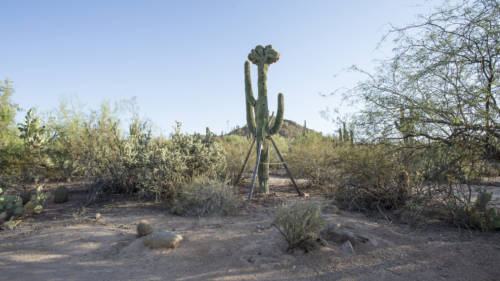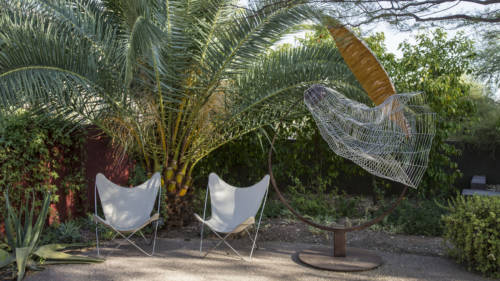
Arizona’s Desert Botanical Garden Is Showing A New Side of the Sonoran
Along the pathway leading to the Desert Botanical Garden in Phoenix, Arizona, three small signs greet visitors: “Welcome to the Sonoran Desert…Where every plant shows us…How life can thrive in these dry lands.”
Reading this as I make my way through the 110-degree summer heat, I begin to wonder what kind of “life” these signs refer to, exactly, as I already feel unsure that I will make it much further, even armed with a hat, sunscreen, hiking shoes, and two bottles of water.
Despite the occasionally oppressive conditions, this 140-acre garden, which sits in the northern Sonoran Desert, is home to an abundance of non-human life. Opened in 1939, Arizona’s Desert Botanical Garden was born out of Swedish botanist Gustaf Starck and philanthropist Gertrude Webster’s desire to conserve their desert environment.
Today, the garden showcases over 50,000 plant displays, as well as desert critters like the Desert Cottontail, the Gambel’s Quail, the Round-tailed Ground Squirrel, and the Gila Woodpecker. The Desert Botanical Garden features five unique trails (mercifully ranging from only ⅓ to ¼ mile), and I choose to begin with the Desert Wildflower Loop Trail, which emphasizes the diversity of wildflowers in North American deserts and their participation in desert ecosystems, which largely takes place through pollination. After learning that Arizona is in fact “the hummingbird capital of the United States” (with 15 recorded species, no doubt) I continue on to the Desert Discovery Loop Trail, that branches off to the remaining three trails.
All five of the garden’s trails feature stunning examples of desert life-– from the Palo Verde, Arizona’s state tree, to the Saguaro Cactus, which does not grow its first arm until 95-100 years of age-– the Center for Desert Living Trail stands out in the summer heat. This trail teaches visitors how to create their own healthy, sustainable, and water-efficient garden amidst the dryness of the desert. The trail itself is made up of an herb garden, vegetable beds, water installations, and shady rest spots, in an effort to manifest what it preaches: visitors leave the garden feeling calmer and cooler than when they entered.
These practices in our home gardens are only the latest in a long history of human attempts to harness the beauty of the desert for our own benefit.
When I reach the Plants and People of the Sonoran Desert Loop Trail, I remember that these practices in our home gardens are only the latest in a long history of human attempts to harness the beauty of the desert for our own benefit. On this trail, I explore the past and current ways in which Native Americans and others have used desert plants for food, fiber, medicine, and ceremony. The trail also shows the five differing habitats of the Sonoran Desert (which itself stretches from Arizona to southern California and down into Mexico): the desert habitat, the mesquite bosque, the desert oasis, the semi-desert grassland, and the chaparral.
I finish up my tour with the Sonoran Desert Nature Loop Trail, which boasts vistas of the surrounding desert and landmarks like Papago Buttes, Piestewa Peak and Camelback Mountain– the perfect spot to catch the upcoming sunset. As the heat neutralizes with the falling sun and a serenity sets over the garden, I am able to take a moment to appreciate the beautiful show of pinks and oranges painting the sky over the distant mountains.
As I head back down the trail (all of the trails close at sunset), I feel that the garden has met its initial promise to show how life can thrive here. Though I am exhausted and caked in sweat, the plants and animals I pass remain unperturbed by the day’s trials. Looking at them now, I understand that they are built for this desert environment, even when we humans aren’t.
In an effort to further its mission, the Desert Botanical Garden holds classes and camps, runs a community garden, hosts events, and has its own research center– all offered with the hope of inspiring visitors to appreciate our deserts, particularly the Sonoran Desert. With this appreciation also comes a desire to protect the desert’s ecosystem and beauty for future generations.
For those heading to Arizona this summer, the Desert Botanical Garden will give you a new appreciation for the plants and animals able to thrive in this seemingly harsh environment-– though as a human, you might want to save your visit until the late afternoon (when the sun is a little less strong) or for the evening flashlight tours (offered on Thursdays and Saturdays).
For more information on the Desert Botanical Garden, visit the garden’s website.
Desert Botanical Garden
1201 N. Galvin Parkway
Phoenix, AZ 85008





































